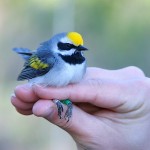Changes to the Endangered Species List
Rare species Conservation in New Jersey
by Margaret O’Gorman, Executive Director

Yesterday, the New Jersey Department of Environmental Protection released a rule proposing certain changes to endangered species list and other considerations about rare wildlife in the state.
The list of species protected on the Endangered Species list has not been updated since 2003. This new proposal reflects years of work by wildlife biologists engaged in endangered species protection.
The rule change proposes to add five species to the list of endangered species in the state and change the consideration of eight other species to offer different levels of protection for breeding and non-breeding populations.
The species being added to the list are the black rail, golden-winged warbler, red knot, Indiana bat and gray petaltail (a dragonfly). The Indiana Bat is being added because it is on the federal endangered species list and any species on this list also found in New Jersey is, by default, considered endangered in New Jersey. The other species are being added to the list as a result of a review of their status using something called the Delphi Technique.
The Delphi Technique is an iterative process whereby wildlife biologists and academics, using the best available data, come to consensus agreement of the status of the species under consideration. This review is then approved by the Endangered and Nongame Species Council which is made up of wildlife biologists, academics and other interested parties. Delphi Reviews of birds, freshwater mussels, butterflies, dragonflies and damselflies were carried out between 2000 and 2005. The results of these reviews inform this proposed rule change.
In addition to adding five species to the endangered species list, the Department is proposing to modify the endangered status of eight species of birds for either the breeding or non-breeding populations.

The bald eagle is currently classified as endangered for both breeding and non-breeding populations. The classification of the bald eagle will continue to be endangered for the breeding population, which includes all bald eagles present in the State during the breeding season. However, the non-breeding population, which includes all bald eagles present in the State outside of the breeding season, will be reclassified as threatened.
Six bird species – the pied-billed grebe, northern harrier, northern goshawk, peregrine falcon, short-eared owl and vesper sparrow – currently listed as endangered for both breeding and non-breeding populations will continue to be classified as endangered for breeding populations but will be listed as special concern for their non-breeding populations.
The Endangered Species List is not a one-way street and while we worry about the removal of protections for species, we must recognize and celebrate the recovery and return of these species. In the 1950’s, no peregrine falcons nested east of the Mississippi River, today our non-breeding population is strong and growing. In the late 1980’s, one pair of bald eagles remained in New Jersey, today the winter population is counted in the high 200’s and the breeding population approaches 100 pairs. Species recovery can succeed and with this proposed rule change, we should celebrate these successes.
But, we should mourn the additions to the list and wonder why, since the Endangered Species Act passed in 1973, we still see declining populations and we still add species to the Endangered Species List in New Jersey.
Discover more from Conserve Wildlife Foundation of NJ
Subscribe to get the latest posts sent to your email.
Leave a Comment
As long has I am allowed to purchase horseshoe crabs in another state. I have no problem with the Red Knot being placed on the endangered species list in N.J..However if this makes it illegal to have hoseshoe crabs in my possesion in N.J. it would put me out of business,since i need the female horseshoe crab for bait ! With todays economy and my age (57) finding a different line of work would be difficult if not impossible. So i would simply ask that any change to the status of the Red Knot have no impact on the livelyhood of the individuals who depend on the use of horseshoe crabs.
Comments are closed.